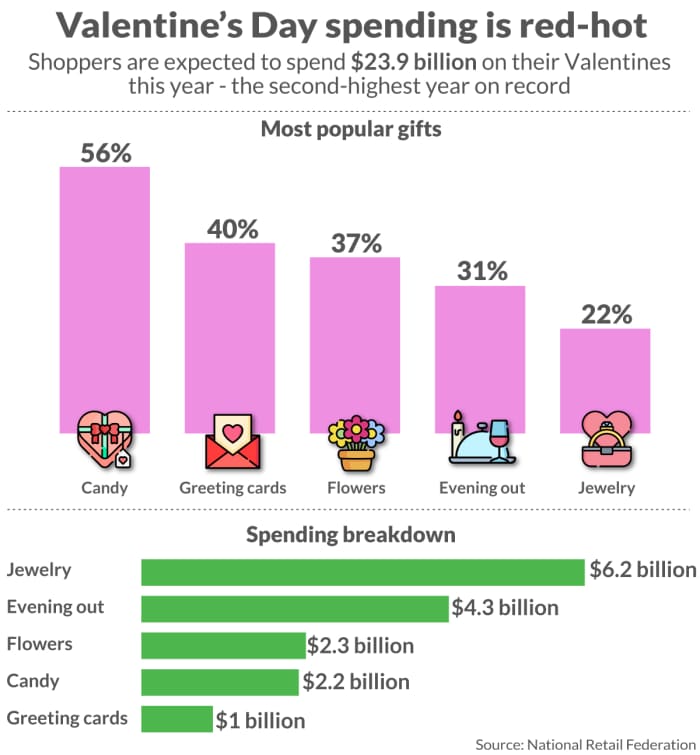This post was originally published on this site
Cupid’s arrow could hit gold.
Americans are expected to spend a collective $23.9 billion this Valentine’s Day, according to the National Retail Federation, which is up from $21.8 billion in 2021. The NRF, which has been conducting its annual Valentine’s Day consumer survey since 2004, says this would make 2022 the second-highest year for Valentine’s Day spending on record.
And that’s in spite of inflation fears striking many shoppers in the heart. The average U.S. household is spending an extra $250 a month, or $3,000 per year, due to high inflation. A smaller survey from Numerator found that nearly three-quarters of consumers say that inflation will affect their Valentine’s spending this year, with half of the respondents saying they expect rising prices to have a “slight” impact on their Valentine’s Day shopping. Almost one in four (24%) expect inflation to have a “significant” impact.
So to combat rising prices, 43% of surveyed consumers told Numerator that they plan to look for promotions and coupons; 32% plan to shop at different retailers; and 24% say they will buy in smaller quantities this year.
Related:15 thoughtful Valentine’s Day gifts under $20 — that don’t seem cheap
Perhaps that explains why more than half (53%) of the almost 8,000 people surveyed by the National Retail Federation still said that they are planning to celebrate the Hallmark holiday on Monday. Shoppers are expected to drop an average of $175.41 each on gifts, which is up from $164.76 in 2021, according to the NRF. And more than 76% of those celebrating Valentine’s Day said it is especially important to do so given the current state of the pandemic.
“Following the historic level of consumer spending over the winter holidays, it appears that the trend will continue into 2022,” NRF president and CEO Matthew Shay said in a statement. “Valentine’s Day is a special occasion for many Americans, even more so as we navigate out of the pandemic, and retailers are prepared to help them mark the holiday in a memorable and meaningful way.”
According to the survey, shoppers plan to spend the most on jewelry ($6.2 billion collectively) and an evening out ($4.3 billion). They’ll also drop $2.2 billion on candy and $1 billion on greeting cards.

Chart by Terrence Horan for MarketWatch
While candy (56%), greeting cards (40%) and flowers (37%) remain the most popular gift items this Valentine’s Day, demand for gifts of experience, such as tickets to a concert or sporting event, has also returned to pre-pandemic levels. Some 41% of those surveyed said they would “love to receive a gift of experience,” which is up from 36% last year. This is especially true for Gen Z and younger millennial shoppers, who are 49% more likely to give the gift of an experience than older generations, according to Numerator.
The Numerator survey suggests that some traditional Valentine’s gifts, such as electronics, accessories and jewelry, are showing multi-year declines among consumers, however — although more than half (52%) of respondents still said they are buying presents for their loved ones this year. And alcohol and food gifts have increased in popularity.
Related: This Valentine’s Day, skip the flowers and talk about money instead
Indeed, this report also found that many people plan to wine and dine with their partners this year as many parts of the country return to normal activities outside the home. More than one-third (36%) of respondents said they plan to go out for food or drinks on Valentine’s Day, which is more than double the 17% who said the same last year. This is steadily climbing back up to the 45% of people who expected to dine out in February 2020; before the pandemic.
There’s no doubt that COVID-19 has left an impact on people’s relationships and their finances over the past two years. Household debt and the overall cost of living increased, while median household income decreased, according to NerdWallet’s annual household debt study.
See also: Struggling? Here are 5 things you can do to fortify your finances.
But at the same time, 58% of Americans told WalletHub that romantic gestures are more important to them now than they were pre-pandemic.


